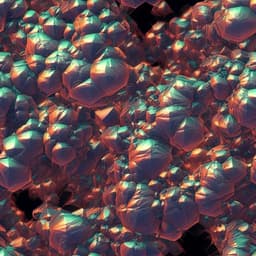
Engineering and Technology
Giant room temperature elastocaloric effect in metal-free thin-film perovskites
C. Li, Y. H. Huang, et al.
This groundbreaking research by Cheng Li, Yu Hui Huang, Jian-Jun Wang, Bo Wang, Yong Jun Wu, He Tian, Long-Qing Chen, and Zijian Hong unveils a thermodynamic model that predicts astonishingly high elastocaloric strengths in metal-free perovskite ferroelectric thin films. The results show eC performance significantly surpassing traditional ferroelectric oxides, hinting at their potential for the next generation of refrigeration technology.
~3 min • Beginner • English
Introduction
The study addresses the need for efficient, environmentally friendly solid-state cooling. Conventional magnetocaloric and electrocaloric materials often require large magnetic or electric fields and deliver limited caloric strengths, hindering practical device integration. Mechanocaloric effects, particularly elastocaloric effects driven by uniaxial stress, offer an alternative route but traditional oxide ferroelectrics exhibit low compressibility, limiting elastocaloric strength and efficiency. Metal-free perovskite ferroelectrics such as [MDABCO](NH4)13 have low mass density and much lower elastic stiffness (~1 GPa) than oxide perovskites (~100 GPa), suggesting that large stress-induced volume and entropy changes may be achievable. The research goal is to develop a thermodynamic model to predict stress/strain-driven phase transitions and quantify the elastocaloric performance of (111)-oriented [MDABCO](NH4)13 thin films under combined in-plane misfit strain and out-of-plane stress, and to identify material parameters that control and can enhance the elastocaloric response at room temperature.
Literature Review
Prior work has shown limited electrocaloric strengths in prototype ferroelectrics (e.g., <1.0 K m MV−1 in PbZr0.95Ti0.05O3 and fluorinated polymer thin films), necessitating large fields and bulky auxiliary systems. Elastocaloric effects have been explored in oxide ferroelectrics (e.g., BaTiO3 thin films with ΔTec ~5 K under ~6.5 GPa; predicted ΔTec/Δσ ~0.7 K GPa−1 in oxide heterostructures) but are constrained by low compressibility. Metal-free [MDABCO](NH4)13 exhibited extraordinarily large electrocaloric strength and temperature change in prior predictions, outperforming BaTiO3 and PbTiO3, attributed to larger Curie-Weiss constants and lower mass density. Colossal barocaloric effects have been reported in plastic crystals (e.g., NPG with ΔS/Δσ ~961.5 J K−1 kg−1 GPa−1), illustrating the role of high compressibility and disorder. Metal-free organic perovskites, stabilized by ionic and hydrogen bonding, display large compressibility and predicted large piezoelectric responses, along with advantages such as mechanical flexibility and low processing temperatures, motivating exploration of their mechanocaloric behavior.
Methodology
A thermodynamic Landau-Devonshire framework is developed for (111)-oriented [MDABCO](NH4)13 thin films, expanding the free energy density up to eighth order in polarization. The total free energy includes polarization, thermal, mechanical, and electric contributions, incorporating electromechanical coupling (electrostriction and higher-order terms), elastic compliance, background permittivity, and linear thermal expansion. Polarization and stress are transformed from local to global coordinates suitable for (111) orientation. A Legendre transformation accounts for epitaxial constraints by introducing in-plane misfit strain. Mixed mechanical boundary conditions are imposed for epitaxial films: in-plane misfit strains fixed and out-of-plane stress applied, with zero shear stresses. For a given misfit strain and applied out-of-plane stress, equilibrium polarization components are obtained by minimizing the transformed free energy at room temperature using material parameters from prior reports. Phase diagrams as a function of misfit strain and stress are mapped by identifying stable polarization states (R, M, O, C phases). Elastocaloric properties are computed from the isothermal entropy change and adiabatic temperature change upon stress variation. The total isothermal entropy change per mass is decomposed into contributions from polarization configuration change (dipolar entropy) and stress-induced volume change proportional to the thermal expansion. The adiabatic temperature change is obtained via thermodynamic derivatives (Maxwell relations), using a constant heat capacity (assumed 1000 J K−1 kg−1 at room temperature). The upper stress limit is set to 1.28 GPa to avoid plastic deformation reported for this material. Refrigerant capacity (RC) is evaluated as ΔTec·ΔSec and coefficient of performance (COP) as absorbed heat divided by specific mechanical work (Q/W), where Q = ∫T dS and W = ∫σ dε.
Key Findings
- A misfit strain–stress phase diagram for (111)-oriented [MDABCO](NH4)13 thin films at room temperature reveals four stable phases (R, M, O, C) depending on in-plane misfit strain and out-of-plane stress; under large compressive stress and compressive misfit strain, the paraelectric cubic phase is stabilized.
- Predicted room-temperature elastocaloric strengths are exceptionally large: isothermal ΔSec/Δσ ≈ 60.0 J K−1 kg−1 GPa−1 and adiabatic ΔTec/Δσ ≈ 17.9 K GPa−1, about 20× higher than BaTiO3 thin films (~0.7 K GPa−1).
- Under an out-of-plane compressive stress of 1.28 GPa and in-plane misfit strain of +0.01, the maximum adiabatic temperature change reaches 22.9 K, with isothermal entropy change up to about −65.4 J kg−1 K−1. With a compressive misfit strain of −0.01, ΔTec ~18.7 K is obtained.
- The calculated refrigerant capacity (RC) is ~1760 J kg−1 and COP ~1.11 under optimal conditions (298 K, Δσ up to 1.28 GPa, misfit strain 0.01).
- Entropy change comprises two competing parts: polarization-induced (ΔS^P) and volume-change-induced (ΔS^V). In soft organic ferroelectrics like [MDABCO](NH4)13, ΔS^V dominates, leading to an order-of-magnitude higher elastocaloric strength than oxide ferroelectrics.
- Design analysis indicates ΔTec increases with thermal expansion coefficient and decreases with elastic compliance, with a stronger dependence on thermal expansion. A fivefold increase in thermal expansion could, in principle, boost ΔTec toward ~100 K at fixed compliance.
- The high elastocaloric performance is attributed to low Young’s modulus (about 1% of conventional oxides) and high thermal expansion of [MDABCO](NH4)13; improvements are projected via reducing modulus or enhancing thermal expansion (e.g., chemical modification).
Discussion
The work demonstrates that metal-free perovskite [MDABCO](NH4)13 thin films can deliver giant room-temperature elastocaloric responses under feasible uniaxial stresses, addressing the challenge of low caloric strengths in conventional ferroelectrics. By mapping phase stability and coupling it to stress/strain, the study clarifies how stress-induced transitions (R→M/C→O) drive large entropy and temperature changes. The decomposition of entropy change shows that the dominant contribution arises from stress-induced volume change due to high thermal expansion and compliance, explaining the superior performance relative to oxide perovskites. Comparative analyses with BaTiO3, PbTiO3, PZT, KNN, KNO, and PVDF show an order-of-magnitude increase in elastocaloric strengths for [MDABCO](NH4)13 at room temperature, along with high RC and moderate COP, indicating promise for efficient miniature cooling. The design-space exploration establishes practical guidelines: enhancing the thermal expansion coefficient (e.g., via chemical substitution of cation/anion species) is more effective than further softening, and substrate-induced misfit strain can tune performance. Practical considerations include maintaining stresses below the plasticity limit (~1.28 GPa) and substrate selection (or freestanding films) to sustain large stresses over devices.
Conclusion
A thermodynamic model for (111)-oriented [MDABCO](NH4)13 thin films was developed to predict stress/strain-driven phase transitions and elastocaloric properties. The films exhibit giant elastocaloric strengths at room temperature (ΔSec/Δσ ~60 J K−1 kg−1 GPa−1; ΔTec/Δσ ~17.9 K GPa−1), maximum ΔTec ~22.9 K, RC ~1760 J kg−1, and COP ~1.11 under 1.28 GPa stress with appropriate misfit strain. The superior performance stems from low Young’s modulus and high thermal expansion; entropy change is dominated by volume effects. Design analysis highlights thermal expansion as the primary lever for further improvement, suggesting chemical modification and compositional tuning of [MDABCO](NH4)13 as promising routes. These findings position metal-free organic ferroelectrics as strong candidates for next-generation elastocaloric cooling devices and motivate experimental validation and materials engineering to realize the predicted performance.
Limitations
- The study is theoretical, based on thermodynamic modeling with parameters from prior reports; experimental validation is not provided.
- A constant heat capacity of 1000 J K−1 kg−1 at room temperature is assumed, which may vary with temperature and phase.
- The maximum applied uniaxial stress is limited to 1.28 GPa to avoid plastic deformation; device designs must accommodate such stresses (e.g., suitable substrates or freestanding films).
- Thin-film, single-domain, epitaxial conditions and specific boundary conditions are assumed; effects of defects, domain structures, and kinetics are not explicitly treated.
- Afforded improvements via chemical modification are projected from trends in thermal expansion and compliance, not yet demonstrated experimentally.
Related Publications
Explore these studies to deepen your understanding of the subject.







